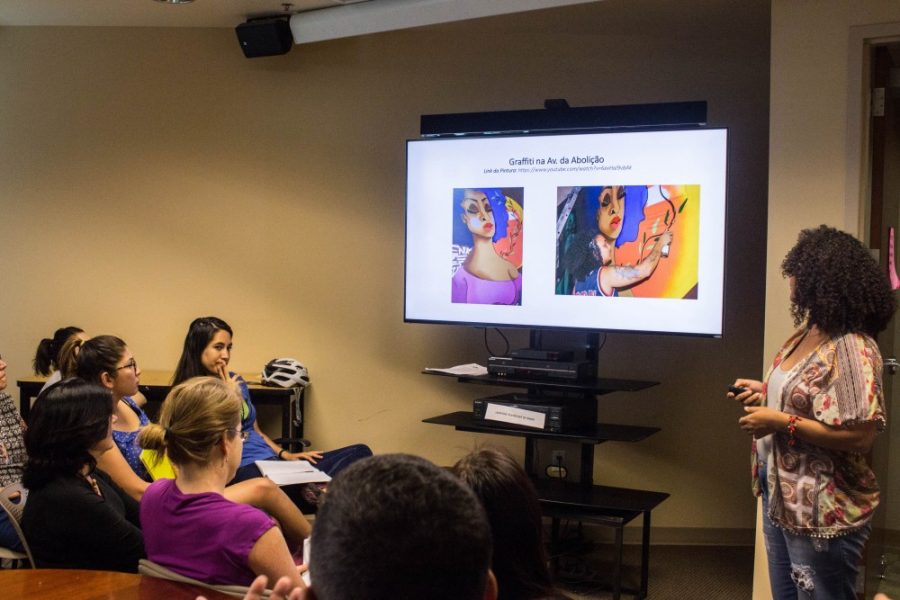Artists who used their work to address issues in a resistence movemnet inspired the University of Arizona’s Department of Spanish and Portuguese to hosted a week of events dedicated to contemporary Brazil.
“Art as Resistance Contemporary Brazil” was created to educate people on the role of art as a form of protest and political action. The events addressed issues of sexism, social justice and politics.
Katia Bezerra, professor and associate head of the department, helped bring these events to campus. Last year, as the director of the Study Abroad Program in Fortaleza, Brazil, Bezerra met artist Alexsandra Ribeiro.
RELATED: Spiritual healing in the desert
“I was really impressed by her work and asked her if she would like to come to Arizona to meet our students,” Bezerra said. “In the case of Brazil, we witness the emergence of artists that have developed a trajectory of social and political engagement, advocating for more inclusive forms of cultural and political participation.”
Along with Ribeiro, professor Dário Borim, a concert producer and radio programmer from the University of Massachusetts Dartmouth, was also invited to attend and speak at lectures.
Bezerra chose Borim because “music also plays a large role in social justice movements,” which is one of the themes that will be discussed.
“In most cases, music and social justice have become so embedded in Brazil as elsewhere. For instance, funk music and rap have given voice to otherwise marginalized groups,” Bezerra said.
Even though many rap songs in Brazil tell stories of the violence and struggles of marginalized communities in everyday life, Borim also discussed some of the common issues of rap music seen in the United States.
“The music industry appropriates black culture, objectifies bodies and reinforces stereotypes. These are some of the topics professor Borim will discuss,” Bezzera said.
Bezzera hopes “Art as Resistance Contemporary Brazil” will encourage student engagement.
“This will encourage a productive exchange of ideas and experiences among the participants,” Bezzera said.
She said she also wanted to educate the audience about the culture and people of Brazil.
“Of course, we also want to challenge some of the myths and stereotypes associated with Brazilian society,” Bezzera said.
The Art as Resistance events came to a conclusion with the lecture “Buzz, Laughter and Spears: Brazilian Music Smacks.” “Buzz” is the spirit of getting really excited, like upbeat music — “Laughter” because a good chunk of music has to do with sarcasm and irony.
“‘Spears’ is the spirit of aggressiveness that has reached a climax in rock and roll that questions everything about society,” Borim said.
RELATED: Creating a festival; the people behind the scenes
The aggressive form of rock and roll relates to how musical artists use their work as a platform to address social issues, according to Borim. He showed the audience various videos of “Brazilian icons” who performed protest songs that were “illegal, using their social power as a form of resistance.”
“Decade after decade, we have had meaningful content come out of Brazil that has to do with social matters; this means anything from political to funny,” Borim said.
Borim also discussed icons that came out of Brazil like Carmen Miranda, who helped make Samba popular in Brazil and the United States.
“Some people ask how good music in Brazil is, and I just say, ‘Imagine if the U.S. had about 20 Bob Dylan’s,’” Borim said.
The second portion of the lecture was given by Ribeiro, whose art is mostly dedicated to empowering women and proving that they “can do what a man can.”
“It’s not easy to be a woman who does street art in Brazil, it is dominated by men,” Ribeiro said.
She proceeded to show videos of her doing graffiti alongside groups of men. Being the only woman in the group of painters, she refers to her art as “urban expressions.” Her videos aim to show the art process from a “woman’s perspective,” especially in a male-dominated field.
She explained to the crowd that the reason why there are so few women in her field is because of the high rates of sexual assault. Ribeiro lives in one of the most dangerous cities in Brazil. Because most work is full time, the financial return of being an artist isn’t as appealing as most jobs, according to Ribeiro.
She also presented another video in which she was graffitiing a mural of a black woman with “many vibrant colors,” all by herself.
“I believe my work is an expression of my identity as a black woman in Brazil,” Ribeiro said.
Other than graffiti, Ribeiro is a social educator with the group Cuca, an outreach program that works with at-risk youth in Fortaleza communities.
The lecture series aimed to bring awareness to the work Brazilian artists produce on the UA campus, “especially the work that serves as a platform for tackling social justice,” according to Bezerra.
Bezerra encourages students to learn more about underrepresented countries and explore the different ways of expressing oneself through art. The Department of Spanish and Portuguese currently sponsors programs in Spain, Chile, Brazil and Costa Rica.
Follow Daily Wildcat on Twitter









